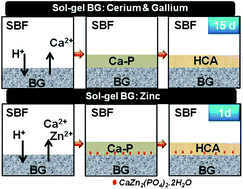Structural and in vitro study of cerium, gallium and zinc containing sol–gel bioactive glasses
Abstract
Sol–gel derived glasses comprised of bioactive materials exhibit a high in vitro response, i.e., the capability to form a hydroxycarbonate

* Corresponding authors
a
Department of Chemistry, University of Modena and Reggio Emilia, Via G. Campi 183, 41125 Modena, Italy
E-mail:
gmalavasi@unimo.it
b
Departamento de Quimica Inorganica, Facultad de Farmacia, Universidad Complutense de Madrid, 28040 Madrid, Spain
E-mail:
salinas@farm.ucm.es
c Networking Research Center on Bioengineering, Biomaterials and Nanomedicine (CIBER-BBN), Madrid, Spain
d Department of Chemistry, University of Pavia and INSTM, Via Taramelli 16, 27100 Pavia, Italy
Sol–gel derived glasses comprised of bioactive materials exhibit a high in vitro response, i.e., the capability to form a hydroxycarbonate

 Please wait while we load your content...
Something went wrong. Try again?
Please wait while we load your content...
Something went wrong. Try again?
S. Shruti, A. J. Salinas, G. Malavasi, G. Lusvardi, L. Menabue, C. Ferrara, P. Mustarelli and M. Vallet-Regì, J. Mater. Chem., 2012, 22, 13698 DOI: 10.1039/C2JM31767B
To request permission to reproduce material from this article, please go to the Copyright Clearance Center request page.
If you are an author contributing to an RSC publication, you do not need to request permission provided correct acknowledgement is given.
If you are the author of this article, you do not need to request permission to reproduce figures and diagrams provided correct acknowledgement is given. If you want to reproduce the whole article in a third-party publication (excluding your thesis/dissertation for which permission is not required) please go to the Copyright Clearance Center request page.
Read more about how to correctly acknowledge RSC content.
 Fetching data from CrossRef.
Fetching data from CrossRef.
This may take some time to load.
Loading related content
